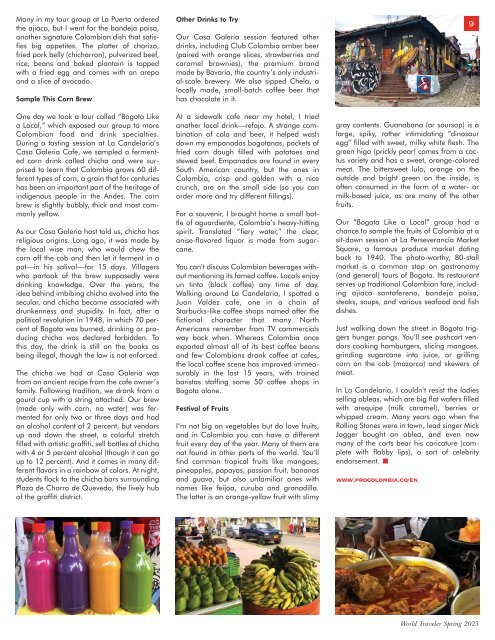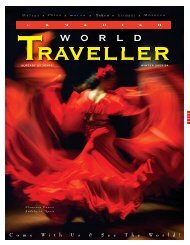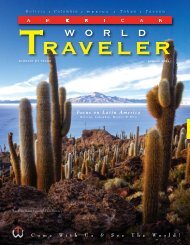Canadian World Traveller Spring 2023 Issue
Now in our 21st year of publishing, Canadian World Traveller explores the culture and history of worldwide destinations, sharing the adventure of discovery with our readers and motivating them to make their travel dreams a reality. Published quarterly, CWT helps sophisticated, independent Canadian travellers choose their next destination by offering a lively blend of intelligent, informative articles and tantalizing photographic images from our World’s best destinations, cruises, accommodations and activities to suit every traveller's taste.
Now in our 21st year of publishing, Canadian World Traveller explores the culture and history of worldwide destinations, sharing the adventure of discovery with our readers and motivating them to make their travel dreams a reality. Published quarterly, CWT helps sophisticated, independent Canadian travellers choose their next destination by offering a lively blend of intelligent, informative articles and tantalizing photographic images from our World’s best destinations, cruises, accommodations and activities to suit every traveller's taste.
You also want an ePaper? Increase the reach of your titles
YUMPU automatically turns print PDFs into web optimized ePapers that Google loves.
Many in my tour group at La Puerta ordered<br />
the ajiaco, but I went for the bandeja paisa,<br />
another signature Colombian dish that satisfies<br />
big appetites. The platter of chorizo,<br />
fried pork belly (chicharron), pulverized beef,<br />
rice, beans and baked plantain is topped<br />
with a fried egg and comes with an arepa<br />
and a slice of avocado.<br />
Sample This Corn Brew<br />
One day we took a tour called “Bogota Like<br />
a Local,” which exposed our group to more<br />
Colombian food and drink specialties.<br />
During a tasting session at La Candelaria’s<br />
Casa Galeria Cafe, we sampled a fermented<br />
corn drink called chicha and were surprised<br />
to learn that Colombia grows 60 different<br />
types of corn, a grain that for centuries<br />
has been an important part of the heritage of<br />
indigenous people in the Andes. The corn<br />
brew is slightly bubbly, thick and most commonly<br />
yellow.<br />
As our Casa Galeria host told us, chicha has<br />
religious origins. Long ago, it was made by<br />
the local wise man, who would chew the<br />
corn off the cob and then let it ferment in a<br />
pot—in his saliva!—for 15 days. Villagers<br />
who partook of the brew supposedly were<br />
drinking knowledge. Over the years, the<br />
idea behind imbibing chicha evolved into the<br />
secular, and chicha became associated with<br />
drunkenness and stupidity. In fact, after a<br />
political revolution in 1948, in which 70 percent<br />
of Bogota was burned, drinking or producing<br />
chicha was declared forbidden. To<br />
this day, the drink is still on the books as<br />
being illegal, though the law is not enforced.<br />
The chicha we had at Casa Galeria was<br />
from an ancient recipe from the cafe owner’s<br />
family. Following tradition, we drank from a<br />
gourd cup with a string attached. Our brew<br />
(made only with corn, no water) was fermented<br />
for only two or three days and had<br />
an alcohol content of 2 percent, but vendors<br />
up and down the street, a colorful stretch<br />
filled with artistic graffiti, sell bottles of chicha<br />
with 4 or 5 percent alcohol (though it can go<br />
up to 12 percent). And it comes in many different<br />
flavors in a rainbow of colors. At night,<br />
students flock to the chicha bars surrounding<br />
Plaza de Chorro de Quevedo, the lively hub<br />
of the graffiti district.<br />
Other Drinks to Try<br />
Our Casa Galeria session featured other<br />
drinks, including Club Colombia amber beer<br />
(paired with orange slices, strawberries and<br />
caramel brownies), the premium brand<br />
made by Bavaria, the country’s only industrial-scale<br />
brewery. We also sipped Chela, a<br />
locally made, small-batch coffee beer that<br />
has chocolate in it.<br />
At a sidewalk cafe near my hotel, I tried<br />
another local drink—refajo. A strange combination<br />
of cola and beer, it helped wash<br />
down my empanadas bogotanas, pockets of<br />
fried corn dough filled with potatoes and<br />
stewed beef. Empanadas are found in every<br />
South American country, but the ones in<br />
Colombia, crisp and golden with a nice<br />
crunch, are on the small side (so you can<br />
order more and try different fillings).<br />
For a souvenir, I brought home a small bottle<br />
of aguardiente, Colombia’s heavy-hitting<br />
spirit. Translated “fiery water,” the clear,<br />
anise-flavored liquor is made from sugarcane.<br />
You can’t discuss Colombian beverages without<br />
mentioning its famed coffee. Locals enjoy<br />
un tinto (black coffee) any time of day.<br />
Walking around La Candelaria, I spotted a<br />
Juan Valdez cafe, one in a chain of<br />
Starbucks-like coffee shops named after the<br />
fictional character that many North<br />
Americans remember from TV commercials<br />
way back when. Whereas Colombia once<br />
exported almost all of its best coffee beans<br />
and few Colombians drank coffee at cafes,<br />
the local coffee scene has improved immeasurably<br />
in the last 15 years, with trained<br />
baristas staffing some 50 coffee shops in<br />
Bogota alone.<br />
Festival of Fruits<br />
I’m not big on vegetables but do love fruits,<br />
and in Colombia you can have a different<br />
fruit every day of the year. Many of them are<br />
not found in other parts of the world. You’ll<br />
find common tropical fruits like mangoes,<br />
pineapples, papayas, passion fruit, bananas<br />
and guava, but also unfamiliar ones with<br />
names like feijoa, curuba and granadilla.<br />
The latter is an orange-yellow fruit with slimy<br />
gray contents. Guanabana (or soursop) is a<br />
large, spiky, rather intimidating “dinosaur<br />
egg” filled with sweet, milky white flesh. The<br />
green higo (prickly pear) comes from a cactus<br />
variety and has a sweet, orange-colored<br />
meat. The bittersweet lulo, orange on the<br />
outside and bright green on the inside, is<br />
often consumed in the form of a water- or<br />
milk-based juice, as are many of the other<br />
fruits.<br />
Our “Bogota Like a Local” group had a<br />
chance to sample the fruits of Colombia at a<br />
sit-down session at La Perseverancia Market<br />
Square, a famous produce market dating<br />
back to 1940. The photo-worthy, 80-stall<br />
market is a common stop on gastronomy<br />
(and general) tours of Bogota. Its restaurant<br />
serves up traditional Colombian fare, including<br />
ajiaco santafereno, bandeja paisa,<br />
steaks, soups, and various seafood and fish<br />
dishes.<br />
Just walking down the street in Bogota triggers<br />
hunger pangs. You’ll see pushcart vendors<br />
cooking hamburgers, slicing mangoes,<br />
grinding sugarcane into juice, or grilling<br />
corn on the cob (mazorca) and skewers of<br />
meat.<br />
In La Candelaria, I couldn’t resist the ladies<br />
selling obleas, which are big flat wafers filled<br />
with arequipe (milk caramel), berries or<br />
whipped cream. Many years ago when the<br />
Rolling Stones were in town, lead singer Mick<br />
Jagger bought an oblea, and even now<br />
many of the carts bear his caricature (complete<br />
with flabby lips), a sort of celebrity<br />
endorsement.<br />
www.procolombia.co/en<br />
9<br />
<strong>World</strong> Traveler <strong>Spring</strong> <strong>2023</strong>















